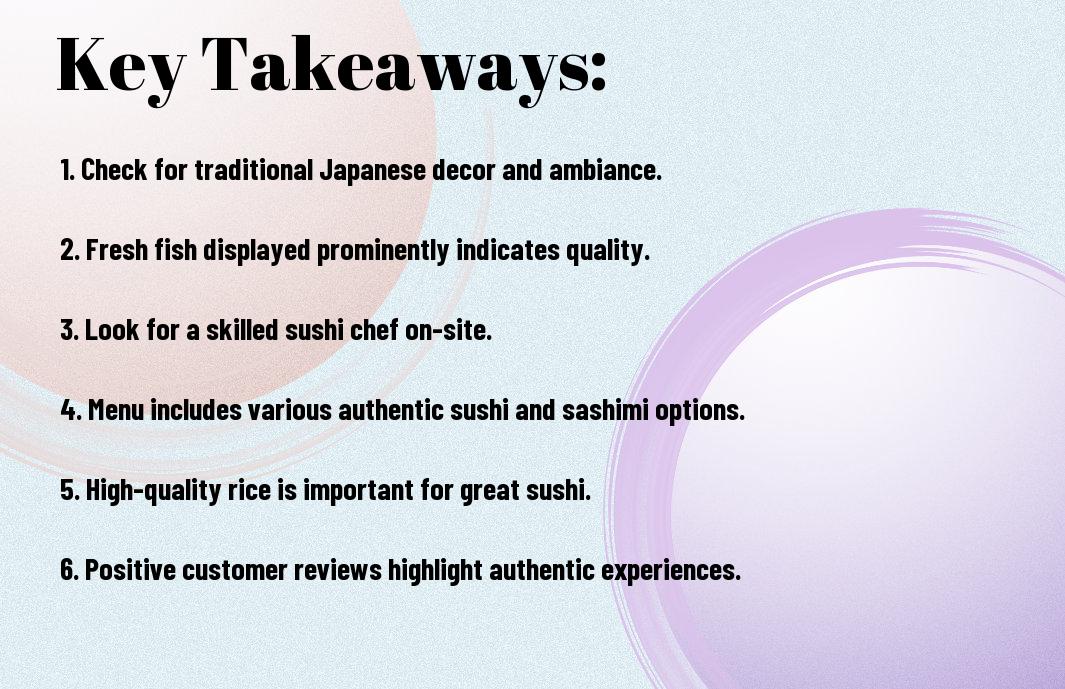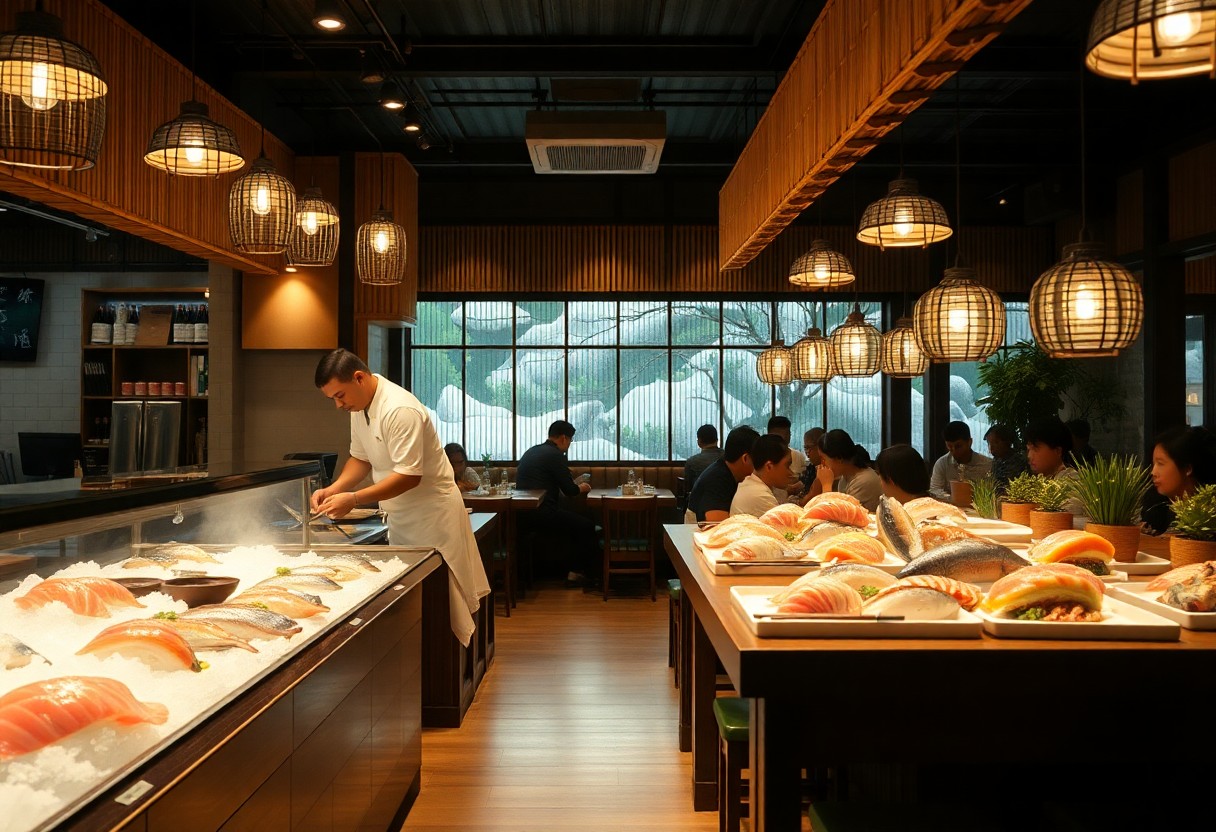There’s a world of difference between genuine sushi and its imitations, and knowing how to distinguish them can elevate your dining experience. When you’re on the hunt for authentic sushi, you’ll want to pay attention to factors like the quality of ingredients, the skill of the chef, and the overall ambiance of the restaurant. For insights on sushi authenticity, check out Answerman – Is My Sushi Authentic?. In this post, you’ll explore key indicators that will guide you to making the right choice for your sushi cravings.
Key Takeaways:
- Fresh Ingredients: An authentic sushi restaurant prioritizes the use of high-quality, fresh fish and other ingredients, ensuring a superior dining experience.
- Omakase Menu: A legitimate sushi establishment often offers an omakase menu, showcasing the chef’s specialty and seasonal ingredients, allowing for a unique culinary journey.
- Skilled Sushi Chefs: Look for well-trained sushi chefs, usually wearing traditional attire, who have honed their skills over years of practice, reflecting artistry and dedication.
- Traditional Atmosphere: Authentic sushi restaurants often feature minimalistic decor and a serene ambiance that complements the dining experience, including bar seating for direct chef interaction.
- Respect for Craft: Observe the level of care and respect shown by the staff towards the sushi, including proper slicing techniques and plating, which signifies commitment to the craft.
Recognizing the Quality of Ingredients
A key indicator of an authentic sushi restaurant is the quality of ingredients used in its dishes. You should seek out establishments that prioritize fresh, high-grade fish and produce. Inspecting the freshness and sourcing of these ingredients can help you evaluate authenticity. You can learn more about this in our guide on How to Spot An Authentic Japanese Restaurant.
Freshness of Fish
With sushi, the freshness of the fish is paramount. Look for restaurants that offer daily deliveries of fish, and take note of the color, smell, and texture. Fresh fish will have a bright color and a clean, oceanic aroma, while fish that is past its prime may appear dull or have a strong, unpleasant smell.
Sourcing Practices
With an increasing awareness of sustainability, the sourcing practices of sushi restaurants matter greatly. Seek out places that prioritize seasonal fish and are transparent about their sources. Authentic sushi chefs often have relationships with trusted suppliers and may even display certifications or sourcing information on their menus.
And engaging with the restaurant staff can provide insight into their sourcing standards. Ask where the fish comes from, and if they follow sustainable practices. A restaurant that takes pride in its sourcing will be eager to share this information, ensuring that you are not only enjoying quality sushi but also supporting responsible seafood practices.

Understanding the Menu
There’s a distinct difference between authentic sushi restaurants and their imitations, starting with the menu. When reviewing the offerings, look for an emphasis on traditional Japanese dishes that showcase both simplicity and quality ingredients. Authentic menus typically reflect a commitment to genuine flavors and preparation methods, allowing you to appreciate the essence of Japanese cuisine.
Authentic Japanese Dishes
Dishes like nigiri, sashimi, and temaki should take center stage, as they embody the true spirit of sushi. You may also find seasonal items that highlight the freshness and quality of ingredients used. A focus on these established staples indicates the restaurant’s dedication to preserving culinary traditions.
Specialty Items
One aspect that distinguishes authentic sushi restaurants is their specialty items, often featuring unique and regional offerings. These items typically showcase innovation while still adhering to traditional techniques. By exploring these selections, you enhance your dining experience and gain insight into the chef’s creativity.
Consequently, specialty items can provide a deeper connection to Japanese culinary culture. Think of local fish varieties seldom found in typical sushi spots or exclusive rolls that incorporate seasonal ingredients. These dishes not only elevate your meal but also serve as a testament to the chef’s expertise and passion for authentic Japanese cuisine.
Evaluating the Atmosphere
For an authentic sushi experience, the restaurant’s atmosphere plays a vital role. You should look for a clean, well-maintained space that reflects the Japanese dining culture, showcasing a balance between simplicity and elegance. Ambient lighting, calming colors, and subtle decorations can all enhance your dining experience, immersing you in a true sushi atmosphere.
Traditional Decor
One of the first elements to notice is the traditional decor, which typically includes bamboo accents, washi paper, and art with a Japanese influence. These design features are intentional, creating a warm and inviting environment that honors the cultural significance of sushi.
Dining Experience
Behind the decor, the dining experience itself is a hallmark of authenticity. You should expect attentive service that enhances your meal, as well as an ambiance that encourages appreciation of the food.
To elevate your experience, pay attention to how the staff interacts with you and the attention to detail in service. Authentic sushi restaurants often emphasize the art of dining, where you can savor each dish at a leisurely pace. This approach allows you to appreciate the presentation and flavors as they were intended, creating an unforgettable culinary journey.

Observing the Chef’s Skills
To determine the authenticity of a sushi restaurant, take a moment to observe the chef at work. An experienced sushi chef will deftly handle every aspect of sushi preparation, showcasing their mastery of knife skills, rice precision, and ingredient selection. Look for their focus on technique and the pride they take in crafting each piece of sushi, as these qualities are indicative of a genuine commitment to their craft.
Techniques and Presentation
Below are critical indicators of an authentic sushi experience. Pay attention to the chef’s knife techniques—watch how they slice fish with precision and manage the rice with care. A true sushi artist will ensure that each piece looks visually appealing, with an eye for detail that elevates the presentation, maximizing your enjoyment of the food.
Interaction with Patrons
At authentic sushi restaurants, chefs often engage with patrons, sharing their knowledge and passion for sushi. A welcoming demeanor and readiness to answer inquiries about the ingredients or preparation process foster a genuine connection. This interaction not only enhances your dining experience but also reflects the chef’s commitment to creating a warm, inviting atmosphere.
Plus, when chefs interact with you, it demonstrates their confidence and enthusiasm about their craft. They may share insights into the origins of different sushi styles, recommend pairings, or even teach you about seasonal ingredients. This personal engagement enhances your appreciation for the meal and creates a memorable experience, showing that the restaurant values not just the food, but also the relationships built with its customers.
Checking Customer Reviews
All the information you gather about a sushi restaurant will help you assess its authenticity. Customer reviews provide valuable insights, highlighting both the quality of the food and the overall dining experience. Whether they rave about the freshness of the fish or the skill of the sushi chef, these reviews can help you make an informed decision before stepping inside.
Online Feedback
Customer reviews found online, on platforms like Yelp or Google, are a great tool for gauging the reputation of a sushi restaurant. Take note of the frequency and consistency of positive comments regarding specific dishes, as well as any criticisms that may suggest a lack of authenticity or poor practices.
Word of Mouth
Mouth-to-mouth recommendations from family and friends can be powerful indicators of a genuine sushi dining experience. Personal experiences often provide a sense of trust that online reviews might not convey. You can learn about hidden gems in your area or avoid places that may not meet your expectations.
Even if a restaurant has glowing online reviews, word of mouth from those you trust can offer unique perspectives that aren’t captured in online feedback. Friends and family might share stories about their dining experiences or even the specific sushi chef’s expertise, helping you find establishments that consistently deliver authentic flavors and quality. When seeking sushi, be sure to ask around—those personal anecdotes can guide you toward a memorable meal.
Assessing Service Quality
Once again, the service quality at a sushi restaurant can offer great insight into its authenticity. An attentive and knowledgeable staff can enhance your dining experience, making you feel welcome and informed about the dishes being served. Pay attention to how the servers interact with you; they should be eager to share their expertise and guide you through your meal, ensuring you get the full sushi experience.
Knowledge and Attentiveness
Above all, a knowledgeable staff plays a significant role in assessing the authenticity of a sushi restaurant. You should expect your servers to be well-versed in the menu, including different types of sushi, ingredients, and preparation methods. Their attentiveness to your needs and questions will indicate a commitment to providing a genuine dining experience.
Cultural Practices
Among the key elements to consider are the cultural practices observed by the restaurant. Authentic sushi restaurants often adhere to traditional Japanese customs, from the way sushi is presented to the etiquette followed during meal service.
And, these cultural practices can manifest in several ways. For instance, some restaurants may offer a traditional omakase experience, where the chef hand-selects dishes tailored to your tastes. You might also notice specific rituals, such as proper chopstick etiquette or a bow upon entering. The attention to detail in these practices not only enriches your meal but also reflects the restaurant’s dedication to preserving the authentic sushi dining culture.
Summing up
Presently, spotting an authentic sushi restaurant involves a few key observations. You should pay attention to the restaurant’s decor, which often reflects traditional Japanese aesthetics, and gauge the freshness and quality of the fish, as well as the variety offered. Notice how the chefs prepare your sushi; skilled chefs demonstrate craftsmanship and passion for the art. Additionally, examining the clientele can provide insights—locals often favor genuine establishments. By considering these factors, you can enhance your sushi dining experience and confidently choose a restaurant that offers true authenticity.
FAQ
Q: What are the signs of an authentic sushi restaurant?
A: Look for a focus on traditional Japanese techniques and ingredients. An authentic sushi restaurant often features a limited menu with fresh, high-quality fish and vinegar-seasoned rice. Additionally, the presence of a sushi chef with experience in traditional preparation methods can indicate authenticity.
Q: How does the atmosphere help determine if a sushi restaurant is authentic?
A: An authentic sushi restaurant typically has a warm, inviting atmosphere that reflects Japanese culture. Look for traditional decorations, such as calligraphy or Japanese art, and a clean, minimalist aesthetic. Comfortable seating at the sushi bar where you can observe the chefs at work is another positive sign.
Q: What should I look for in the menu of a sushi restaurant?
A: An authentic sushi restaurant will offer a concise menu that highlights seasonal fish and authentic preparations, like nigiri, sashimi, and rolls that are true to Japanese tradition. Avoid places with overly elaborate or fusion dishes, as this may deviate from authentic sushi preparations.
Q: How important is the fish quality in an authentic sushi restaurant?
A: The quality of fish is one of the most significant indicators of an authentic sushi restaurant. Fresh, high-quality fish should have a vibrant color and a clean, ocean-like smell. Sushi chefs take great care in sourcing their fish, often specializing in particular types or regions, so inquire about their fish sourcing methods to gauge authenticity.
Q: What role does the sushi chef play in identifying an authentic sushi restaurant?
A: The sushi chef’s skill and knowledge are vital in determining the authenticity of a sushi restaurant. An experienced chef will have undergone years of training in traditional sushi preparation and etiquette. Engaging the chef in conversation can provide insight into their background, the techniques they use, and their approach to sourcing ingredients, which can all help establish authenticity.
